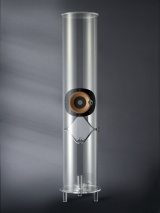Products Polifemo

Polifemo: the acoustic resonator variable and fine adjustments
The Helmholtz resonator is a device to control resonance is very well known. It consists of a volume of air enclosed in a cavity, coupled with the outside through an opening to form a mechanical system of the type mass-spring with its own resonance frequency, at which the system is in able to absorb a considerable part of energy. The absorption of a resonator of this type is very selective about the frequency of resonance and particularly effective in the case of low-frequency tones.
However, a resonator is not only to absorb.
The principle of the resonator was used already in antiquity to increase the volume of the voice actors in the theatre air and amplify the vibration of the strings of instruments like guitar, violin and other strings.The resonator has so far found little application in domestic environments suitable to reproduce music.
The reason is very simple.
To develop a resonant device effective to combat the specific acoustic problems of a very specific environment should be a precise instrument, such that the device is really effective in dealing with the critical frequency of that 'environment without affecting the others. Resonator works in a narrow band and broadband, such as the DAADs work.
A resonator is therefore a system stiff, fixed and built to a very specific environment. It has to be well calculated, by having to interface between the environment and the speakers. This is important if you do not want to cause a acoustic disaster. Despite the potential of the device, it has been up to now very difficult to use in the home environment and thus has been little used.
Polyphemus is the modern application of the principle of Helmholtz making it possible use this feature free of usual problems and have effective use of the resonator in the home environment and many more positive side effects.
Polyphemus can be adapted to any acoustic environment issues or problems. Through some substantial technical change its resonance frequency accorded to that required in a certain environment.
Its possibilities are almost limitless.
Starting at 26 Hz, Polifemo gives the opportunity to work on any frequencies in a clean and well-defined way. Changing the environment or replacing the speakers may not be nessesary. Polifemo may be employed to fully exploit the potential and the lost potential of an existing system.
Polyphemus has a cylindrical shape.
At the base, which is appropriately elevated from the ground, two holes of different diameters that can be opened or closed, individually, to achieve different combinations of intervention.A half cylinder there is the "eye" of Polyphemus, a sophisticated iris diaphragm, whose aperture can be changed seamlessly. The arrangement of the openings of the device is not random. Since it can be considered as a speaker, the orientation of the 'eye', which is obtained by rotating the entire device, influences the distribution of the sound environment, address as more convenient in terms of representation of space , tone, dynamics of the reproduced sound. Inside the cylinder there is a further possibility of adjustment: a swinging sound-absorbing membrane changes timing and the velocity of the air flow inside. Also this changes the response of the system to adapt to the needs of listening.
All these possibilities of Polyphemus can be managed by instrumental and / or by the senses. The results are striking to the ear and during the instrumental analysis phases.
In addition to the precise control and articulation of bass frequencies, the result is that Polifemo creates a clear enlargement of the space as a result of better resolution at the low frequencies, and an improvement of how the medium and high frequencies "float" on the low.
When the system is properly tuned, Polifemo is at it's most striking in terms of dynamics, which is enhanced by realism, gaining in terms of micro-information.In one household room of a traditional size one or two may be needed. These can be tuned in a different ways to correct asymmetry of the soundstage and to solve various problems. In some cases, to obtain the best results 3 or 4 can be used.
Generally these must be arranged in the corners or the middle of the walls and can be used with other acoustic treatment systems such as DAAD or Eco DAAD.

























